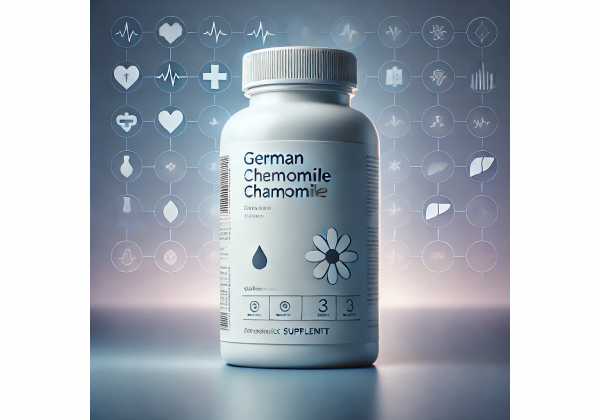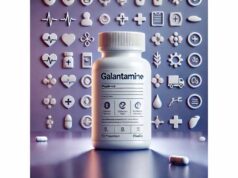
German chamomile (Matricaria recutita), also called Chamomilla recutita or Matricaria chamomilla, is one of the world’s most widely used calming herbs. People reach for it to ease digestive discomfort, quiet anxious tension, support sleep, soothe irritated skin and mouth tissues, and add a gentle floral note to teas and baths. Its essential oil contains azulene pigments formed from matricin during distillation, lending a distinctive blue color and anti-inflammatory activity, while flavonoids such as apigenin interact with brain and gut pathways linked to calm and comfort. Modern clinical research suggests modest benefits for anxiety and selected skin and oral conditions, with tea and standardized extracts used most often. This guide distills what matters: how German chamomile works, where it helps, how to use it correctly, smart dosage ranges for tea and extracts, mistakes to avoid, and who should skip it. You will also find a concise evidence summary and safety notes you can trust.
Essential Insights
- May modestly reduce symptoms of generalized anxiety and improve oral and skin comfort in select settings.
- Typical tea dose: 1–2 g dried flowers per cup, up to 3–4 cups daily; standardized extracts ~250–1,000 mg/day short term.
- Stop if you develop allergy symptoms; cross-reactivity can occur in people allergic to ragweed and other Asteraceae.
- Avoid essential oil ingestion; topical oil should be diluted to 0.5–2% and kept away from infants’ faces.
- People on anticoagulants, sedatives, or with hormone-sensitive conditions should discuss use with a clinician.
Table of Contents
- What is German chamomile and how does it work?
- Proven benefits and where it helps
- How to use German chamomile day to day
- How much German chamomile to take
- Common mistakes and troubleshooting
- Side effects, interactions, and who should avoid it
- Evidence summary and research notes
What is German chamomile and how does it work?
German chamomile is an annual daisy-like herb native to Europe and Western Asia and now cultivated worldwide. Herbalists use its dried flower heads (Chamomillae flos) for teas, liquid extracts, capsules, topical rinses and compresses, and steam distill the flowers to obtain an essential oil. The essential oil is naturally blue when fresh because heat converts a sesquiterpene precursor (matricin) into chamazulene, a pigment with notable anti-inflammatory properties.
Chamomile’s activity is best understood through its two major phytochemical groups:
- Volatile oils (terpenoids): α-bisabolol, bisabolol oxides, and chamazulene. These constituents are linked to anti-inflammatory and antispasmodic effects that can calm smooth muscle in the gastrointestinal tract and reduce skin and mucosal irritation.
- Flavonoids and phenolics: apigenin, luteolin, quercetin, and related glycosides. Apigenin is often spotlighted for interacting with GABA-A receptor sites, a pathway shared with conventional anxiolytics, which helps explain chamomile’s calming profile without strong sedation in most people.
Because chamomile contains both water-soluble flavonoids and oil-soluble terpenoids, preparation matters. A hot water infusion (tea) prioritizes flavonoids and water-extractable components. Alcohol-based tinctures and standardized extracts capture broader phenolics and some volatile components. Steam-distilled essential oil is highly concentrated in terpenoids but nearly devoid of flavonoids; it is for aromatic or topical dilute use only, never oral ingestion.
Beyond chemistry, chamomile’s traditional indications align with mechanisms seen in the lab and clinic: gentle digestive support (gas, cramping, functional dyspepsia), easing anxious tension, and soothing irritated skin and oral tissues. Its safety profile is generally favorable in short-term, customary amounts, but allergy risk exists in people sensitive to plants in the Asteraceae family.
Finally, a note on naming: “German chamomile” (Matricaria recutita) is distinct from “Roman chamomile” (Chamaemelum nobile). They share overlapping traditional uses but differ in chemistry; this article focuses on German chamomile.
Proven benefits and where it helps
Anxiety and stress-related symptoms. Several clinical trials and recent systematic reviews suggest that oral German chamomile can modestly reduce anxiety symptoms, particularly in generalized anxiety disorder (GAD) and situational anxiety. Benefits are typically small to moderate, and they appear within two to eight weeks. Chamomile is not a replacement for evidence-based psychotherapy or medication in moderate to severe cases, but it may complement these approaches for people who prefer a gentle option with a favorable safety profile.
Sleep quality support. Chamomile’s reputation as a bedtime tea comes from its calming effects. Trials show mixed results: some populations (for example, postpartum individuals or older adults) report fewer nighttime awakenings and better subjective sleep quality, while other trials find little effect on objective sleep duration. Where benefits occur, they tend to be modest and often depend on consistent evening use and a relaxing pre-bed routine.
Oral and skin comfort. German chamomile preparations—especially mouth rinses and gels—are used to soothe oral mucosa during stressful treatments. Evidence suggests chamomile can reduce oral mucositis severity and discomfort when applied regularly. For skin, diluted topical chamomile may ease itch and irritation in mild dermatitis or after minor procedures. As with many botanicals, product quality and formula dictate results.
Digestive relief. Traditional use for gas, cramping, and functional gastrointestinal discomfort is long-standing. Mechanistically, antispasmodic terpenoids and flavonoids can help calm smooth muscle and modulate local inflammation. Clinical findings range from supportive to inconclusive, reflecting variable formulations and small study sizes. Many people still find practical benefit from a warm cup after meals.
Menstrual comfort. Small studies and traditional use suggest chamomile tea or extracts may ease cramping and associated mood symptoms. While promising, these findings are not uniform, and effects are typically modest.
What to expect. With correct dosing and steady use, improvements often appear within 1–2 weeks for anxious tension and sleep quality, and more quickly (days) for oral or skin comfort when used topically. The effect size is generally gentle, which many users prefer when they want support without strong sedation.
Who benefits most. Chamomile is best positioned for mild anxiety, transient sleep difficulties, functional digestive upset, and soothing inflamed oral or skin tissues—especially when someone values a plant-based option and can use it consistently.
How to use German chamomile day to day
Choose the right form for your goal
- Tea (infusion of dried flowers): Best for gentle calming, digestive comfort, and bedtime routines. It is affordable, easy to prepare, and provides water-soluble flavonoids like apigenin.
- Standardized oral extract (capsules or liquid): Useful when you need measured doses for anxiety or sleep support and prefer not to drink multiple cups daily. Look for products stating the ratio (e.g., 4:1) or a standardized apigenin percent, and keep within short-term use windows unless guided by a clinician.
- Mouth rinse or gel: For irritated oral tissues, mouth sores, or after dental care. Use products formulated for oral mucosa; do not swallow concentrated solutions.
- Topical cream, ointment, or dilute essential oil: For itchy, inflamed skin. Always patch test and dilute essential oil to 0.5–2% in a carrier oil; keep away from eyes and infants’ faces.
- Aromatic use (diffuser/inhalation): For pre-sleep wind-down or easing situational stress. Do not ingest essential oil.
Daily routines that work
- For anxious tension: Take a standardized extract in divided doses with meals, or drink 1 cup of tea up to 3–4 times daily. Pair with slow breathing, a short walk, and caffeine moderation.
- For sleep quality: Brew a stronger evening cup (see dosage section) 30–60 minutes before bed, dim lights, and avoid screens. Consistency night-to-night matters more than a single large dose.
- For digestive comfort: Sip warm tea after meals. Combine with simple habits—eating slowly, limiting late-night heavy meals, and keeping a food diary if symptoms recur.
- For oral soothing: Use a chamomile mouth rinse as directed, typically several times daily after meals and before bed. If you receive medical therapy that affects the mouth, coordinate with your dentist or oncology team before adding any rinse.
- For skin: Apply a thin layer of chamomile cream or a properly diluted essential oil to small areas 2–3 times daily as needed. Stop if redness or itching worsens.
Quality tips
- Check species (Matricaria recutita) on the label.
- Assess lot freshness: whole flower heads retain aroma better than crushed dust in old tea bags.
- Look for standardized extracts when precision matters.
- Avoid fragrance-only products for therapeutic aims; they may lack meaningful actives.
- Store tea and extracts away from heat, light, and moisture.
When to reevaluate
- No improvement after 2–4 weeks of correct use for anxiety or sleep.
- Worsening symptoms, new rash, wheezing, facial swelling, or mouth tingling (possible allergy).
- You start or change anticoagulants, sedatives, or hormone-sensitive therapies; speak with your clinician about continued use.
How much German chamomile to take
Adults
- Tea (dried flowers):
- Single cup: 1–2 g dried flowers in 150–250 mL hot water, covered, steeped 5–10 minutes, then strain.
- Daily amount: Up to 3–4 cups per day for short-term use.
- Bedtime routine: 1 cup 30–60 minutes before sleep; add a second cup earlier in the evening if needed.
- Standardized oral extract (capsules or liquid):
- Common short-term range: about 250–1,000 mg per day in divided doses, depending on product strength. Some trials have used doses up to around 1.5–2 g/day for limited periods under supervision.
- Follow the manufacturer’s suggested serving unless a clinician advises otherwise.
- Mouth rinse or gel:
- Use commercial products exactly as labeled. For homemade infusions used as a rinse rather than a beverage, brew at tea strength, cool fully, swish gently for 30–60 seconds, and spit. Repeat 2–4 times daily.
- Topical applications (creams, ointments):
- Apply a thin layer to clean skin 2–3 times daily.
- Essential oil (topical only, never oral):
- Dilution: 0.5–2% (that is 3–12 drops essential oil per 30 mL carrier oil). Start at the lower end for facial or sensitive areas. Patch test first. Keep away from eyes and mucous membranes.
Older adults
- Start at the low end of ranges, especially with extracts. Consider 1 cup of tea once or twice daily and assess response before increasing. Monitor for dizziness or excessive drowsiness.
Pregnancy and breastfeeding
- Safety data for medicinal-strength doses are limited. Many clinicians consider occasional culinary-strength tea acceptable in healthy pregnancies, but avoid high-dose extracts and essential oil unless your obstetric provider approves. For breastfeeding, avoid essential oil ingestion and keep topicals away from areas that might contact an infant’s mouth.
Children and adolescents
- For teens, adult tea amounts are often acceptable. For younger children, discuss dosing with a pediatric clinician; avoid essential oil use on or near the face and do not give essential oil orally.
Course length
- For anxiety or sleep, try a 2–4 week course. If helpful, some people continue for several more weeks before tapering to the lowest effective amount. For oral or skin comfort, use during the active irritation period and discontinue once healed.
What not to do
- Do not ingest essential oil.
- Do not exceed labeled extract doses without guidance.
- Do not combine with multiple sedative herbs or medications without checking for additive effects.
Common mistakes and troubleshooting
Brewing too weak or too rushed. A tea bag dunked for two minutes delivers little more than aroma. Use 1–2 g flowers per cup, cover while steeping 5–10 minutes, and drink while warm. For bedtime, brew earlier so you are not waking to urinate.
Expecting immediate, strong sedation. Chamomile is calming, not a knockout sedative. Benefits often appear as less mental tension and fewer nighttime awakenings, not necessarily longer total sleep. Build a consistent routine—dim light, slower breathing, gentle stretches—so the tea becomes a cue for wind-down.
Using the wrong product for the job. A scented lotion may smell nice but lack sufficient active constituents for irritated skin. For oral mucosa, choose a mouth rinse or gel designed for that tissue. For anxiety, a standardized extract provides more consistent dosing than sporadic tea.
Overusing essential oil or applying it neat. Essential oil is highly concentrated. Always dilute to 0.5–2%, patch test, and avoid infants’ faces and direct eye contact. Stop immediately if you notice burning, redness, or breathing changes.
Ignoring potential allergies. If you are allergic to ragweed, chrysanthemums, marigolds, or daisies, you may react to chamomile. Watch for itching, hives, lip or tongue swelling, wheezing, or throat tightness—and seek medical care if they occur.
Not coordinating with medications. Even gentle herbs can interact. If you use anticoagulants/antiplatelets, sedatives, or hormone-sensitive therapies, speak with your clinician. Document brand, dose, and schedule so your care team can advise appropriately.
Assuming “more is better.” Higher doses can increase side effects (nausea, dizziness) without adding benefit. Use the lowest effective dose and take breaks to reassess.
Skipping product quality checks. Choose products that list Matricaria recutita and provide lot number, manufacturer, and strength. For tea, select recently packed whole flowers with a fresh aroma.
Troubleshooting tips
- No effect after 2 weeks for anxiety or sleep: Adjust timing (e.g., afternoon plus evening), verify dose, and pair with behavioral strategies. If still ineffective by 4 weeks, reconsider your plan with a clinician.
- Stomach upset: Reduce dose, take with food, or switch to tea instead of capsules.
- Skin irritation from topicals: Stop immediately; try a hypoallergenic base or a lower essential-oil dilution.
Side effects, interactions, and who should avoid it
Common side effects (uncommon overall): mild nausea, dizziness, or sleepiness, especially at higher extract doses. Eye irritation can occur if products contact the eyes.
Allergy risks: People allergic to plants in the Asteraceae family (ragweed, chrysanthemum, marigold, daisy) can react to chamomile. Reactions range from contact dermatitis to anaphylaxis. Stop at the first sign of rash, hives, wheezing, mouth or throat swelling, or severe itching.
Medication interactions:
- Anticoagulants and antiplatelets: Chamomile contains coumarin-related constituents, raising long-standing theoretical concerns about added bleeding risk, especially with warfarin. Contemporary randomized studies in healthy volunteers have not shown clinically meaningful changes in prothrombin time with short-term tea or extract, yet caution remains prudent for anyone actively taking anticoagulants. Coordinate with your prescriber.
- Sedatives and CNS depressants: Additive calming effects are possible. Start low, avoid combining with multiple sedatives, and do not drive until you know how you respond.
- Hormone-sensitive conditions: Chamomile may exhibit estrogen-like effects in some contexts. Individuals with conditions sensitive to estrogen exposure should discuss use with their clinicians.
Who should avoid or obtain medical advice first
- History of severe allergies to Asteraceae plants.
- Pregnancy or breastfeeding when considering medicinal-strength doses or concentrated extracts. Occasional culinary-strength tea may be acceptable, but get personalized guidance.
- Infants and toddlers: Avoid essential oil exposure near the face and do not administer essential oil orally.
- People on warfarin or other anticoagulants, strong sedatives, or hormone therapies should seek individualized advice.
Practical safety steps
- Record your product, dose, and timing.
- Start at the low end and reassess every 1–2 weeks.
- For topicals, patch test inside the forearm for 24 hours before regular use.
- If you need surgery or a procedure, tell your clinical team about chamomile and follow their perioperative guidance.
Evidence summary and research notes
Anxiety: Multiple randomized trials and a recent systematic review and meta-analysis indicate that oral German chamomile can modestly reduce anxiety symptoms, particularly in generalized anxiety disorder and situational anxiety. Doses in trials vary (roughly 250 mg to 2,000 mg/day of extract, or 1–2 cups of tea daily), and benefits are typically observed over two to eight weeks. Not every study shows benefit; heterogeneity in formulations and dosing likely explains variability.
Sleep: Evidence is mixed. Some RCTs in specific groups (for example, postpartum individuals and older adults) report improved subjective sleep quality or fewer nocturnal awakenings. Objective sleep duration often does not change. As a low-risk component of a broader sleep routine, chamomile may still have value for many.
Oral and skin comfort: Clinical reviews suggest chamomile mouthwashes or gels can reduce oral mucositis severity and pain when used consistently. For skin, small trials and longstanding practice support use of creams and ointments to ease mild inflammatory irritation. Stronger evidence is needed to standardize dosing and formulations.
Digestive symptoms: Traditional use is robust; modern trials show promising but inconsistent results for functional gastrointestinal complaints. Antispasmodic and anti-inflammatory constituents provide a rationale, and many people report practical benefit from post-meal tea.
Safety: Short-term use in customary amounts appears well tolerated in adults and children, with rare significant adverse events. Allergy remains the main serious risk. Regarding blood coagulation, modern randomized data in healthy volunteers show no clinically meaningful prolongation of standard coagulation tests after chamomile tea or extract taken for a week; however, prudence is warranted for anyone on anticoagulants because clinical situations differ and study populations were limited.
Research gaps
- Standardization: trials use different species, extraction methods, and doses; harmonized protocols would clarify true effect sizes.
- Long-term safety: data beyond 8–12 weeks are limited.
- Special populations: more research is needed for pregnancy, lactation, older adults with polypharmacy, and patients on anticoagulants.
Bottom line: German chamomile is a gentle, evidence-supported option for mild anxiety and selected oral or skin applications, with mixed—but sometimes meaningful—help for sleep and digestive comfort. Its safety profile is favorable when used short term and correctly. Quality, dose, and consistent routines make the difference between “a pleasant cup” and a noticeable benefit.
References
- Assessment report on Matricaria recutita L., flos and Matricaria recutita L., aetheroleum (first version) 2015 (Guideline)
- Chamomile: Usefulness and Safety | NCCIH 2024 (Guideline)
- The Effect of Oral Chamomile on Anxiety: A Systematic Review and Meta-Analysis 2024 (Systematic Review)
- Effect of chamomile intake on blood coagulation tests in healthy volunteers: a randomized, placebo-controlled, crossover trial 2023 (RCT)
- Effect of Chamomile on the Complications of Cancer: A Systematic Review and Meta-Analysis 2023 (Systematic Review)
Disclaimer
This article is for educational purposes only and does not replace medical advice, diagnosis, or treatment. Herbal products can interact with medications and may not be appropriate for everyone. Always consult a qualified healthcare professional before starting, stopping, or combining German chamomile with any therapy, especially if you are pregnant or breastfeeding, have allergies to Asteraceae plants, or take anticoagulants, sedatives, or hormone-sensitive medications.
If you found this guide useful, please consider sharing it with friends or colleagues on Facebook, X (formerly Twitter), or your favorite platform, and follow us for future updates. Your support helps us continue creating high-quality, evidence-based content.










